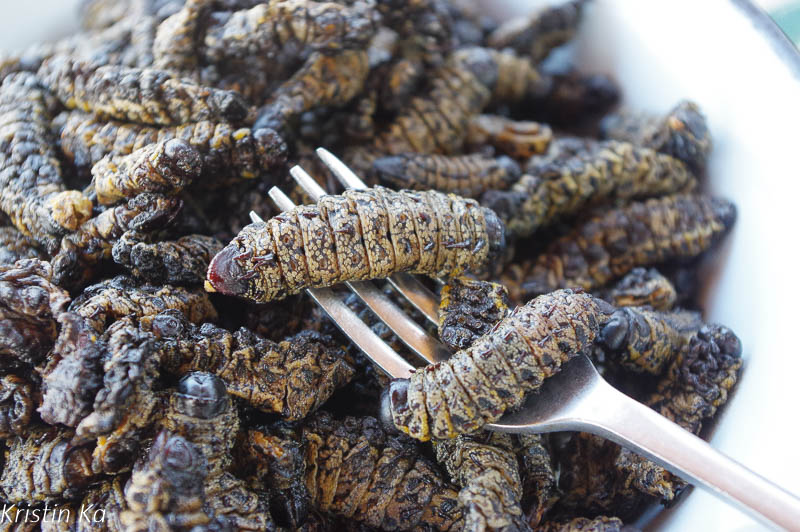How about a little caterpillar stew?
When I was a child, we used to sing in the school canteen: it’s good, it’s hot, it’s slimy, it’s crunchy under the tooth! More, more, more! At that time, none of us knew what was going on in the other side of the world for lunch time. I imagine that if we had known, we would have eaten our infamous boiled beef tongue and our awful ratatouille with delight.Luckily in life, everything happens in the end and I swear on the school teacher’ head, the caterpillars are really good.
So what is this crunchy and tasty caterpillar?
This caterpillar is commonly known as the Mopane or Madora caterpillar. Its scientific name is Gonimbrasia belina. Mopane is the name of the tree on which it feeds mainly this fat caterpillar to be eaten every spring. When the caterpillar has eaten enough and is quite large, it drops from the tree and sinks into the ground to pupate, i.e. to transform itself into a butterfly. At this time of the year, it really rains caterpillars and the inhabitants only have to pick them up.
If you manage to overcome your cultural repulsion, you will discover a food rich in taste, protein and other healthy ingredients.
Dehydrated Muyaya can be bought in Zambian markets wrapped in a newspaper cone. Beware, they are large caterpillars, measuring the size of an adult thumb. Less than 200g of dried caterpillars can feed a family and provide more protein than meat, which is sometimes difficult to find in these regions.
The caterpillar, a source of protein, is under threat from all sides
This providential harvest is not without consequences. As the caterpillar is exceptionally rich in protein, the pickers sometimes have a heavy hand. Moral, the number of caterpillars will decrease. But even without overexploitation for food purposes, the beautiful Madora is a victim of wood felling: no trees, no caterpillars.
Caterpillar stew recipe: too easy to prepare!
To cook them well, they must be rehydrated by leaving them in water at least overnight and then boil them for 10 to 15 minutes. Then just throw them in the pan and cook them with all kind of vegetables. They then become soft in the pan, but they are still a little bit crunchy.
In Africa, they are traditionally accompanied by Nshima and spiced with chilli (very hot). There is no real recipe, you can cook it with any vegetable. In the city you can find them fried but in my opinion they lose their flavour and nutritional qualities.
To each his caterpillar, his frog, his snail or his snake
I find it very amusing to watch foreigners grimacing at this ancestral dish. They find the taste awful, the consistency to vomit! But this is not the case, I assure you. It is just a cultural, traditional interpretation.
For some Africans, artichokes as we like to eat them, leaf by leaf, are utterly disgusting. And what to say in front of the rest of the world disgusted to see the land of gastronomy, reveling in something as repugnant as a snail or a frog? Overcome your apprehension and taste these beautiful juicy and tender caterpillars, I am sure they will delight your palate!
